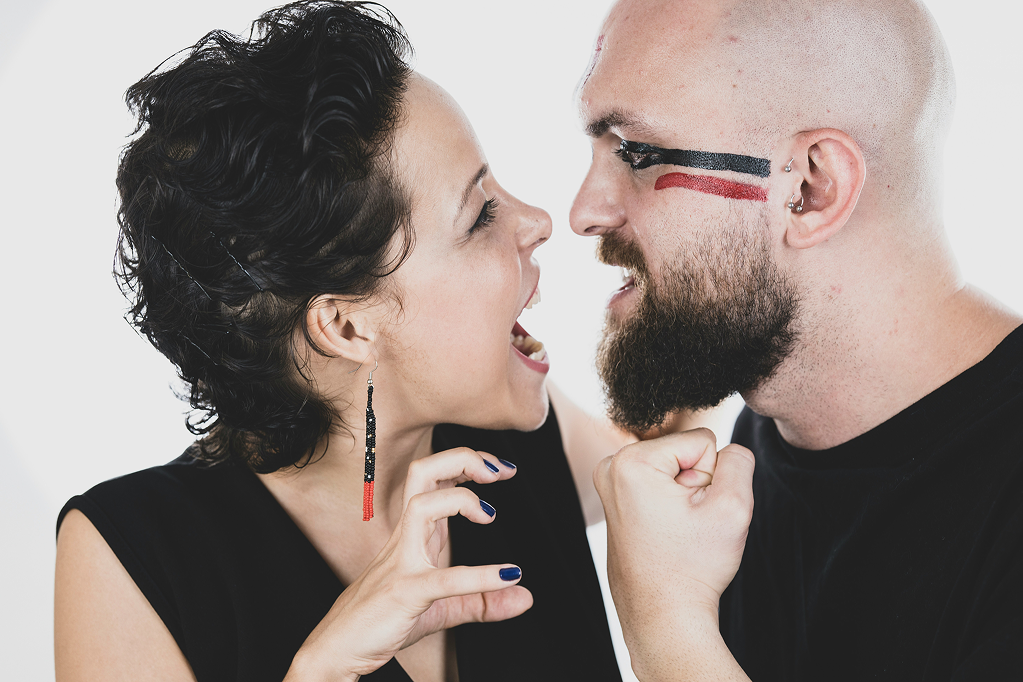After taking a required Intro to Psychology course as an undergrad, I have never looked back. Since my doctoral program, I have specialized in adult relationship therapy. Through my studies and clinicals, I wrote several articles for professional journals and currently in the midst of writing a book.
Disorganized Attachment Style & Romantic Relationships
Have you met someone who unintentionally sabotages your romantic adult relationships? Or are you that person for whom the thought of bonding in a committed relationship causes conflicting emotions? Regardless of your side, dealing with such contradictory behaviors caused by a disorganized attachment style makes your next steps uncertain. We’re here to help you navigate.
3 Insecure Attachment Styles
An attachment style is the way a person reacts and interacts within close relationships.
A person with a disorganized attachment style struggles with one of the three insecure attachment styles. This can make it difficult for them to form and maintain healthy emotional intimacy. Disorganized attachment style is also called fearful avoidant attachment style.
According to attachment theory, there are three insecure attachment diagnoses. All of them are considered problematic because they prevent people from having healthy relationships:
- Disorganized style
- Avoidant attachment
- Anxious attachment style
Is a disorganized attachment style dangerous? It depends, but sometimes it can be a symptom of borderline personality disorder, making people struggle with attachments in relationships. In other cases, a disorganized attachment style creates problems in intimate relationships.
Personality functioning issues also include a broader range of symptoms and behaviors. For example, a personality disorder can impact how a person handles stress in various areas of life. In this situation, it affects not just romantic or personal relationships.
Related reading: Are You In Love or Just Clingy? 8 Love vs Attachment Differences

6 Signs of a Disorganized Attachment Style
How do you know that you or your partner has a disorganized attachment style? The best approach is to speak to a therapist or other mental health professional who understands attachment theory.
If you recognize any of these signs in yourself or your partner, there is a high chance you struggle with a disorganized insecure attachment style:
- You deeply desire connection with others but don’t show it (and you are sure you don’t have an avoidant attachment style)
- You feel uncomfortable being vulnerable with your partner or sharing your emotions
- Your partner’s efforts to connect make you suspicious or uncomfortable
- Your inner dialogue tells you that you are unworthy of love
- You don’t believe your partner when they say they love you or care about you
- You are hypervigilant for proof that your partner is betraying you
It’s great if you recognize the disorganized attachment style problem in yourself, but what if you have it in your partner?
It’s pretty dicey to diagnose any sort of attachment style in another person. But remember: applying labels relating to mental health or personality issues is not a great look. Too many people attempt to diagnose others as a way of deflecting from their issues.
What should you do then? Instead of accusing your partner of having an insecure attachment style, communicate with them. Speak using I and me, and tell them what you have observed that concerns you. Don’t accuse, berate, or diagnose. Certainly, don’t use this as your parting shot if you intend to leave the relationship.
Remember that you don’t have a degree in clinical psychology, and if you did, you wouldn’t diagnose your partner. Instead, encourage communication and counseling. They will need professional help to start healing, and you can learn ways to provide meaningful emotional support.
Related reading: Do Opposites Attract? It’s Not That Simple
Causes for Disorganized Attachment
“In this climate of profoundly disrupted relationships the child faces a formidable developmental task. She must find a way to form primary attachments to caretakers who are either dangerous or, from her perspective, negligent. She must find a way to develop a sense of basic trust and safely with caretakers who are untrustworthy and unsafe.”
Judith Lewis Herman, professor of psychiatry at Harvard Medical School
When someone has a disordered attachment style, they have almost always suffered from some past trauma. Usually, disorganized attachment develops in childhood.
But what exactly causes disorganized attachment? Commonly, our primary attachment figure is usually a parent or other caregiver. If they don’t meet our physical or emotional needs, we can experience attachment disorganization. These attachment relationships can be eroded or severed by early childhood experiences such as physical or sexual abuse.
If spotted timely, child development professionals can notice signs clearly because they are rooted in neglect or trauma. For example, disorganized infants won’t behave like other babies when caregivers enter the room, as these people aren’t attachment figures for them.
However, many children are never diagnosed. That’s because they often don’t receive the kind of care and attention that includes access to mental health care and support. And they become grown-ups who experience severe problems in romance.
People who struggle with fearful avoidant attachment have learned to see those who are supposed to love them and keep them safe as a danger to them. This prevents them from adopting a secure attachment style. Ultimately, they struggle to form meaningful relationships.
Are All People With Disorganized Attachment Styles Victims of Abuse?
Some people show signs of disorganized attachment but don’t report any childhood victimization. That said, it’s important to recognize that even though they may not have been directly abused, many may have witnessed a primary attachment figure commit acts of violence and abuse on others.
There may be other reasons for disorganized attachment. However, trauma is such a common factor in people lacking a secure attachment style that this is the primary cause.
Related reading: Think You’ve Met a Female Narcissist? Follow the Clues
How Disorganized Attachment Style Looks in a Relationship
People with disorganized attachment styles tend to exhibit many of the same behaviors in an intimate relationship. Still, it is important to understand that disorganized adults don’t act in lockstep. Two people with a disorganized style of attachment can behave quite differently. This often reflects the attachment style of their current romantic partner. Additionally, one person with disorganized attachment may do and say things that are very contradictory.
Here is how a disorganized attachment style can manifest itself in your relationship:
- Constantly asking for affirmation that you love them
- Questioning your motives
- Double checking your whereabouts
- Accusing you of cheating on them
- Fawning over you
- Agreeing to have sex when they don’t really want to
- Picking fights after relationship-affirming events
- Ruining or sabotaging tender moments
- Refusing to communicate during arguments
- Running hot and cold – Very clingy to cold and distant
- Subconsciously ruining relationships through cheating and other behaviors
- Seeking out partners who are incompatible or even abusive
If someone doesn’t realize that they have disorganized attachment, they may not see these behaviors are part of an unhealthy attachment style. Some people who struggle with secure attachment convince themselves that the other person is the problem. Everybody is a source of harm or a potential source of harm. So, their erratic behavior makes sense to them.
Others recognize their behavior as wrong. But, until they understand where that comes from, they simply ruin everything good that comes their way because they believe they are undeserving of love.
This contradiction in behaviors makes some people with disorganized attachment more sympathetic than others. While reacting differently to different behaviors makes sense, it is also important to understand that disorganized attachment is virtually always associated with extremely low self-esteem. This realization is a good start to fix the problem.
What to Do If You Want to Build a Healthy Relationship With a Disorganized Attachment Style
A loving, intimate relationship with someone who has a disorganized or avoidant attachment style is possible. But before trying to fix your romance, you should understand that you cannot heal disorganized attachment for another person.
Don’t try to help someone by excusing or justifying their poor coping skills. As tempting as it may be to compensate for the damage done by that person’s caregivers, that isn’t your job. You won’t be healing their attachment wounds. Instead, you simply encourage them to justify their behavior and continue with maladaptive coping mechanisms.
You must set boundaries to have a successful romantic relationship with someone struggling with attachment. It’s also very important that you communicate, are rigorously honest with them, and are vigilant about behavior from a place of intense fear. But remember that behaviors that seem positive could be maladaptive.
If your partner constantly flatters and fawns over you, they might fear that you will reject or abandon them if they don’t behave that way.
Also, a hypersexual partner may have learned this is the only way to earn love and affection. It takes a strong moral core to recognize these things as problematic rather than simply going along with things that may be convenient or pleasurable for you.
Related reading: Boundaries in Relationships – Keeping Them Healthy
Supporting a Partner With a Disorganized Attachment Style
In adult relationships, it can be difficult to balance supporting someone who has experienced past trauma. We want our romantic partners to learn to love us and themselves healthily. At the same time, we aren’t their substitute parents or therapists. Ultimately, they must be willing to work to learn self-regulation.
Be a source of safety, love, and demand for your partner. You can’t form healthy relationships while excusing abusive or controlling behavior because of your partner’s traumatic experiences.
People with adult attachment issues still crave stable relationships. Let this understanding help you stay calm while facing their insecure attachment behaviors. Don’t get roped into arguments or feel obligated to defend yourself when they question your intentions. Instead, encourage them to communicate their feelings productively, use positive coping skills, and engage in therapy to build a stronger sense of self.
Maintaining friendships and family ties outside of your relationship is also important. Encourage your partner to do the same.
Related reading: How To Maintain Your Individuality While In a Relationship
Finally, educate yourself about adult attachment issues. When you understand what your partner is experiencing, it can help you not take their behaviors personally. You’ll be better able to control your own emotions and be a source of stability. For example, simply understanding the internal working models of attachment can help you see where your partner struggles to form secure bonds and why.
Meanwhile, be sure that you are:
- Engaging in therapy on your own
- Staying in contact with friends and family
- Pursuing independent interests and hobbies
- Firmly demanding respect for your own boundaries

4 Myths About Disorganized Attachment Style
We know that people with disordered attachment types struggle with self-worth and fear of rejection. But, there are also some pervasive myths. Let’s go through those.
1. People With Attachment Issues Lack Empathy
You’re dating someone who needs constant assurance that you love them. They’ve even outright accused you of cheating based on flimsy evidence. On top of that, you have to deal with contradictory mental states that leave you feeling exhausted and off balance. Then, after all of this, they cheat on you. Who could behave this way if they aren’t some sort of manipulative sociopath with no regard for other’s feelings?
Related reading: Is Sexting Cheating? It’s Complicated
Sadly, the self-sabotaging behavior of people with attachment issues can often come off as manipulative or worse. Also, because they spend so much time on their internal emotional struggles, they are often blinded to how their behaviors impact others.
But this isn’t a lack of empathy. Most people who deal with this feel terrible about the damage they cause. They simply lack the emotional bandwidth to navigate their emotions and yours in intimate relationships.
2. You Can Love Someone Out of This
Love and stability are necessary for people who want to develop healthy relationships. But your love alone cannot save your partners from their problems.
The truth is that there isn’t really a cure for disorganized attachment problems. Still, your love and support can serve as a foundation for seeking therapy and developing skills to help your partner relate to you and others in healthier ways. That’s the maximum you can expect.
Remember that it is never your job to cure emotional or mental disorders for other people. If you try, you will simply end up centering your life around theirs. Ultimately, that won’t cure them, and your self-worth will take a hit in the process.
Related reading: Toxic Love: Are You Feeling It?
3. The Parental Figure Is Always to Blame
When it comes to disorganized attachment, things are usually more complicated than simply having a hard childhood or negative experiences in the past.
First, while the actions of a child’s caregivers are often behind this issue, things may be more complex. For example, it isn’t just objectively evil, abusive people who have children with attachment issues.
Children separated from their parents because of war often have insecure attachments as adults. Other people develop disorganized attachment because of illness or death.
Also, there is a difference between acknowledging early childhood trauma and dwelling within it. Your partner can recognize things that happened to them, process their emotions, and even label these traumas as their source of fear in adult relationships. However, nobody gets to re-do their childhoods, so the path to healing must always look forward.
4. They Are Different in Other Relationships, So They Can Be More Loving With Me
We get it: you feel you are the only one to suffer from your partner’s unresolved trauma. Meanwhile, they can have healthy close relationships with friends and coworkers. So you hope they can change for you.
The bitter truth is that many people with attachment issues cannot form healthy relationships at all.
People with disorganized attachment tend to lose friendships and romantic connections, and those having seemingly functional relationships often engage in masking behaviors. Such situations happen to them because they repress emotions and behaviors that they know are off-putting to others.
So, why don’t they do that with you? They may see you as a safe person to share their feelings with, even the toxic ones. Also, it’s much harder to maintain a mask in an intimate relationship. Eventually, the facade cracks. That’s hard to deal with, but ultimately the best.
People With Disorganized Attachment Can Love and Be Loved
People with disorganized attachment can feel love and have healthy romantic relationships if they recognize and decide to get out of their psychological problems. And the way out usually starts with love and support, yet healthy communication and the demand to change from their partner.
If you struggle with disorganized attachment yourself, understand that it isn’t your fault, but it is your responsibility to become as healthy as possible. Yes, you tend to sabotage relationships, but that isn’t written in stone. You can seek therapy and develop healthy strategies to form lasting romantic bonds.
If your partner has this problem, the maximum you can give them is being a source of love and encouragement. This strategy, combined with a commitment to your own peace and happiness, will give you and your partner the best chance at success and a secure relationship. And if they don’t change, think twice: do you really want to be seen as a romantic attachment figure by someone who feels the need to hide their authentic feelings?








